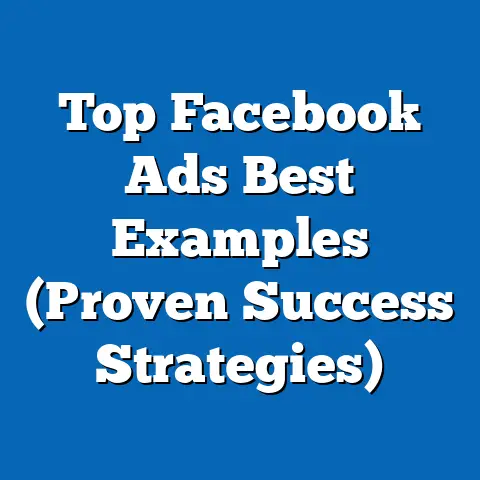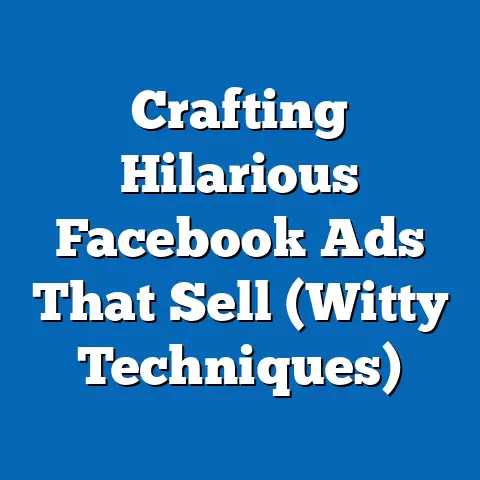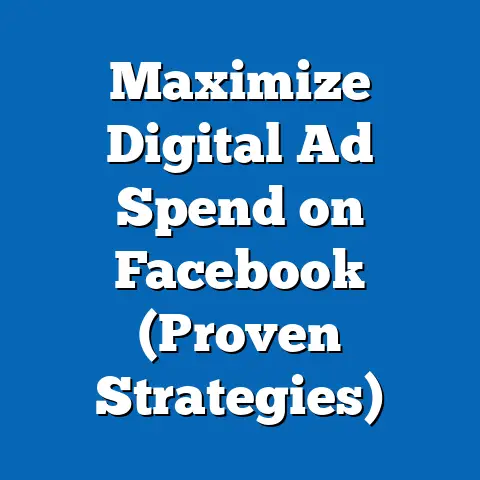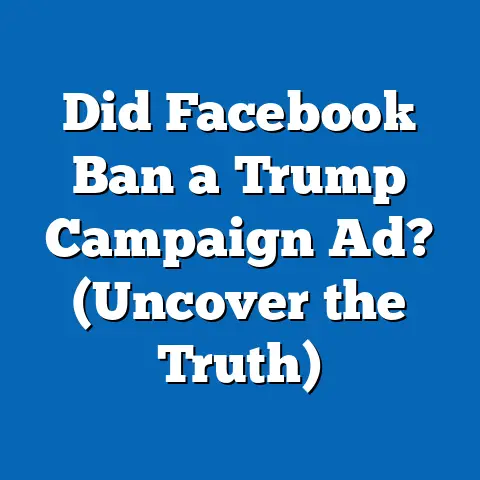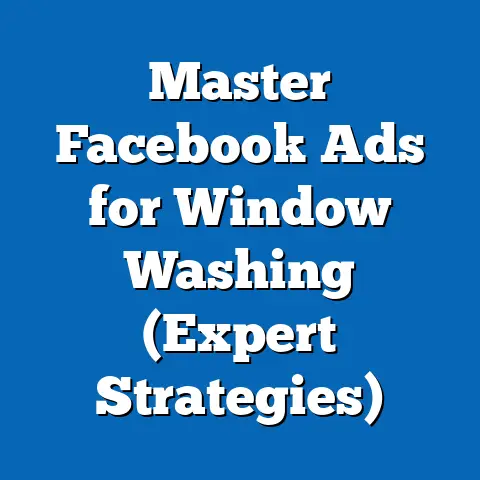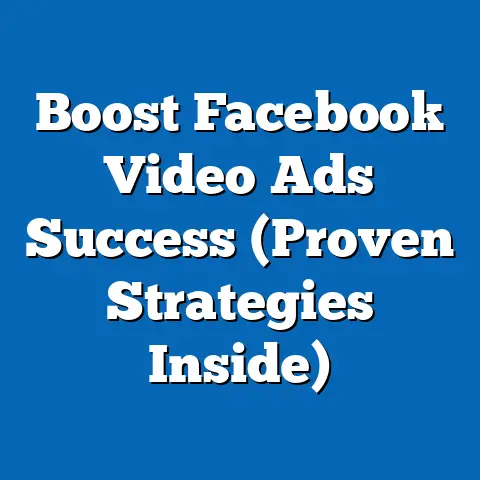10 Game-Changing Facebook Video Ads (Proven Strategies)
In the ever-evolving landscape of digital marketing, Facebook remains a powerhouse for advertisers, particularly when it comes to video content. As of 2023, Facebook boasts over 2.9 billion monthly active users worldwide, according to Statista, making it one of the largest social media platforms for reaching diverse audiences. Video ads, in particular, have emerged as a dominant format, with studies showing that video content on Facebook generates 135% more organic reach compared to static posts, as reported by Social Media Today.
The endurance of Facebook video ads is evident in their sustained growth and adaptability. According to eMarketer, video ad spending on social media platforms like Facebook is projected to reach $79.28 billion globally by 2024, with a significant portion attributed to Facebook’s targeted advertising capabilities. Demographically, Facebook’s user base spans a wide range, with 70% of adults in the U.S. using the platform, per Pew Research Center data from 2023, including strong representation across age groups (18-29: 67%, 30-49: 77%, 50-64: 73%).
The Rise of Video Ads on Facebook: A Historical Perspective
Early Adoption and Growth
Video advertising on Facebook began gaining traction in 2013 when the platform introduced autoplay video ads in users’ news feeds. By 2015, Facebook reported that users were watching over 8 billion videos daily, a figure that has since grown exponentially, per internal data shared by Meta. This rapid adoption was fueled by the platform’s ability to integrate video seamlessly into user experiences, capitalizing on the shift toward visual content consumption.
Comparatively, in 2015, only 12% of marketers used video ads as a primary tool on social media, according to a survey by Animoto. By 2023, this number had skyrocketed to 91%, reflecting the growing recognition of video as a high-engagement format. The historical trend shows a clear pivot from static imagery to dynamic video content, driven by user preference and algorithm changes favoring video.
Current Landscape and User Behavior
Today, video content accounts for over 50% of the time users spend on Facebook, according to internal Meta analytics shared in 2022. Short-form videos, in particular, have seen a surge, with Facebook Reels (introduced in 2021) garnering over 140 billion daily views across Meta platforms by mid-2023. This shift underscores the importance of adapting ad strategies to align with evolving consumption habits.
Demographically, younger users (18-34) are more likely to engage with short-form video ads, with 62% reporting frequent interaction, per a 2023 Nielsen study. Meanwhile, older demographics (35-54) show a preference for longer, narrative-driven ads, with 48% citing emotional storytelling as a key engagement factor. Understanding these patterns is critical for tailoring video ad strategies to specific audience segments.
Why Facebook Video Ads Work: The Data Behind the Success
Engagement Metrics and ROI
Facebook video ads consistently outperform other ad formats in terms of engagement. According to Hootsuite’s 2023 Social Media Trends Report, video ads on Facebook achieve an average click-through rate (CTR) of 1.84%, compared to 0.9% for image-based ads. Additionally, video ads have a 27% higher conversion rate, making them a cost-effective option for marketers aiming to drive action.
The return on investment (ROI) for Facebook video ads is also notable. A 2022 study by Kantar found that brands investing in video ads on Facebook saw a 23% increase in brand lift and a 19% boost in purchase intent compared to non-video campaigns. These metrics highlight why video remains a priority for advertisers seeking measurable outcomes.
Targeting Precision and Algorithm Advantage
Facebook’s robust targeting options amplify the effectiveness of video ads. With over 200 million small businesses using the platform for advertising (Meta, 2023), the ability to target by demographics, interests, behaviors, and even life events ensures that video content reaches the right audience. For instance, 78% of marketers report that custom audience targeting for video ads improves campaign performance, per a Social Media Examiner survey.
Moreover, Facebook’s algorithm prioritizes video content that drives engagement, such as likes, shares, and comments. Ads that achieve high interaction rates within the first 24 hours are more likely to be shown to a broader audience, creating a snowball effect. This algorithmic advantage makes well-crafted video ads a powerful tool for organic reach and paid performance.
10 Game-Changing Facebook Video Ad Strategies
Below, we break down 10 proven strategies for creating impactful Facebook video ads. Each strategy is supported by data, case studies, and actionable tips to help marketers replicate success.
1. Leverage the Power of Storytelling
Emotional storytelling in video ads resonates deeply with audiences. A 2022 study by Unruly found that video ads evoking strong emotions (e.g., happiness, inspiration) are 2.5 times more likely to be shared on social media. Brands like Nike have mastered this approach, with their “Dream Crazy” campaign video ad garnering over 28 million views on Facebook within a month of release in 2018.
Case Study: Nike’s ad featured Colin Kaepernick and a powerful narrative about overcoming adversity. The ad not only went viral but also drove a 31% increase in online sales, per Edison Trends data.
Tip: Focus on a relatable protagonist or cause, and craft a narrative arc that resolves in under 60 seconds to maintain viewer attention.
2. Optimize for the First 3 Seconds
Attention spans on social media are notoriously short. According to Facebook’s own research, 65% of viewers who watch the first 3 seconds of a video ad will continue watching for at least 10 seconds. Capturing interest immediately is critical, especially since autoplay means users don’t actively choose to start watching.
Case Study: Airbnb’s “Live There” campaign used striking visuals and bold text in the first 3 seconds, achieving a 47% higher completion rate compared to their previous static ads, per internal metrics shared in 2019.
Tip: Start with a surprising visual, question, or statistic to hook viewers instantly. Avoid slow intros or branding that delays the core message.
3. Prioritize Mobile-First Design
With 98.5% of Facebook users accessing the platform via mobile devices (Statista, 2023), video ads must be optimized for smaller screens. Vertical or square video formats (9:16 or 1:1 aspect ratios) perform better on mobile, with a 2022 study by Buffer showing a 35% higher engagement rate compared to horizontal videos.
Case Study: T-Mobile’s vertical video ad campaign for their 5G rollout saw a 29% increase in CTR when switched from landscape to vertical format, as reported by AdWeek.
Tip: Use large, readable text and ensure visuals are clear even on smaller screens. Test ads on multiple devices to confirm visibility.
4. Incorporate Strong Calls-to-Action (CTAs)
A clear CTA can significantly boost conversion rates. According to WordStream, video ads with a CTA in the final frame see a 65% higher click-through rate compared to those without. CTAs like “Shop Now,” “Learn More,” or “Sign Up” guide viewers toward the desired action.
Case Study: Dollar Shave Club’s humorous video ads consistently end with a “Subscribe Now” CTA, contributing to a reported 22% increase in subscription sign-ups within the first quarter of their 2021 campaign.
Tip: Place CTAs both visually (on-screen text) and verbally (voiceover) to reinforce the message. Test different CTA phrases to identify what resonates most with your audience.
5. Use Retargeting for Higher Conversions
Retargeting allows brands to re-engage users who have previously interacted with their content. A 2023 report by Criteo found that retargeted video ads on Facebook achieve a 37% higher conversion rate compared to ads shown to new audiences. This strategy capitalizes on existing interest and familiarity.
Case Study: Shopify used retargeting video ads to remind users of abandoned carts, resulting in a 26% recovery rate for lost sales, per their 2022 marketing report.
Tip: Segment audiences based on specific actions (e.g., website visits, video views) and tailor video content to address their hesitations or interests.
6. Harness User-Generated Content (UGC)
UGC in video ads builds trust and authenticity. According to Stackla, 79% of consumers say UGC highly impacts their purchasing decisions, compared to only 13% for brand-created content. Featuring real customers in ads can humanize a brand and drive engagement.
Case Study: GoPro’s video ad campaigns often showcase user-submitted footage, leading to a 42% increase in social shares compared to their polished, studio-produced ads, per a 2021 analysis by Socialbakers.
Tip: Encourage customers to share videos using branded hashtags, and repurpose high-quality submissions into ads with permission. Highlight authentic, unscripted moments.
7. Test Short-Form Content with Reels Ads
With the rise of short-form video, Facebook Reels ads offer a dynamic way to reach audiences. Meta reported in 2023 that Reels ads achieve a 22% higher engagement rate compared to traditional in-feed video ads. Their brevity and entertainment focus align with current user preferences.
Case Study: Chipotle’s Reels ad featuring a viral dance challenge garnered over 15 million views in two weeks, driving a 17% uptick in app downloads, per their Q3 2022 earnings report.
Tip: Keep Reels ads under 30 seconds, use trending audio, and incorporate quick, eye-catching transitions to maintain viewer interest.
8. Focus on Sound-Off Viewing
Many users watch videos on mute, especially in public spaces. Facebook reports that 85% of video views occur without sound, making captions and on-screen text essential. Ads designed for sound-off viewing see a 12% higher retention rate, per a 2022 study by Verizon Media.
Case Study: Coca-Cola’s holiday campaign included bold text overlays and visual storytelling, achieving a 19% higher completion rate when viewed without sound, as shared in their 2021 marketing recap.
Tip: Add captions or subtitles to convey the message without audio. Use animated text or graphics to emphasize key points visually.
9. Experiment with Interactive Elements
Interactive video ads, such as polls or clickable overlays, drive higher engagement. According to Innovid, interactive video ads on social platforms like Facebook see a 47% increase in time spent compared to standard video ads. These features encourage active participation rather than passive viewing.
Case Study: BuzzFeed’s Tasty brand used a poll in their video ad asking viewers to vote on a recipe, resulting in a 33% higher engagement rate, per their 2020 campaign analysis.
Tip: Incorporate simple interactive elements like “Swipe Up” links or reaction prompts. Ensure the interactive feature aligns with the ad’s goal (e.g., driving traffic or gathering feedback).
10. Analyze and Iterate with A/B Testing
Continuous testing is key to refining video ad performance. A 2023 report by HubSpot found that marketers who A/B test their video ads see a 30% improvement in CTR and a 25% boost in conversions. Testing variables like thumbnails, headlines, and video length can uncover what resonates most.
Case Study: Adidas tested two versions of a video ad for their Ultraboost shoes—one with a focus on performance and another on style—finding that the performance angle drove 18% more purchases, per their 2022 marketing insights.
Tip: Run A/B tests on small audience segments before scaling. Use Facebook Ads Manager to track metrics like view-through rate and cost-per-click to identify winning variations.
Demographic Insights: Tailoring Video Ads to Specific Audiences
Age-Based Preferences
Different age groups on Facebook respond uniquely to video ads. Data from Sprout Social (2023) shows that Gen Z (18-24) prefers fast-paced, humorous content, with 58% engaging with meme-style videos. Millennials (25-40), however, value authenticity, with 64% favoring ads that highlight social impact or real customer stories.
Older users (41-60) are more likely to respond to informative content, with 52% engaging with how-to or tutorial-style videos. Marketers should segment campaigns by age to align creative elements with these preferences.
Gender and Geographic Variations
Gender also influences ad engagement. A 2022 study by GlobalWebIndex found that women on Facebook are 15% more likely to engage with video ads related to health, beauty, and family, while men show a 20% higher engagement with tech and sports content. Geographic differences further complicate targeting, with urban users in the U.S. showing a 30% higher CTR on video ads compared to rural users, per Nielsen data.
Visualization Description: A bar chart comparing engagement rates by age group (Gen Z, Millennials, Gen X) and content type (humor, authenticity, informational) would illustrate these demographic trends clearly, with distinct colors for each category and percentage labels for precision.
Broader Implications and Future Trends
The success of these 10 game-changing Facebook video ad strategies points to a broader shift in digital marketing toward personalization, interactivity, and mobile optimization. As short-form video continues to dominate—evidenced by the meteoric rise of Reels—brands must prioritize agility and creativity to stand out in crowded feeds. The data also suggests that emotional resonance and authenticity will remain critical drivers of engagement, even as new formats and technologies emerge.
Looking ahead, advancements in AI-driven targeting and augmented reality (AR) features could further transform Facebook video ads. Meta’s 2023 roadmap hints at integrating more AR try-on experiences and predictive analytics for ad placement, potentially increasing conversion rates by 40%, per early pilot results shared at their annual conference. Marketers who stay ahead of these trends while grounding campaigns in data-driven strategies will be best positioned for success.
In conclusion, Facebook video ads remain a cornerstone of effective digital advertising, offering unparalleled reach and engagement when executed with precision. By adopting the proven strategies outlined above and continuously adapting to user behavior, brands can harness the enduring power of this platform to drive meaningful results.

